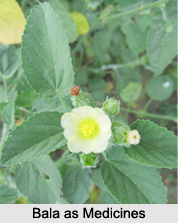 Sida Cordifolia well known in India as Bala is a weed that grows wild in wastelands and along roadsides. According to Ayurveda, "Bala" balances all the doshas - Vata, Pitta and Kapha. It has more effect on vata dosha. Four varieties of bala are mentioned by Sanskrit writers, namely, Batyalaka (Sida cordifolia), Mahabala (Sida rhomboidea), Atibala (Sida rhombifolia), Nagabala (Sida alba).
Sida Cordifolia well known in India as Bala is a weed that grows wild in wastelands and along roadsides. According to Ayurveda, "Bala" balances all the doshas - Vata, Pitta and Kapha. It has more effect on vata dosha. Four varieties of bala are mentioned by Sanskrit writers, namely, Batyalaka (Sida cordifolia), Mahabala (Sida rhomboidea), Atibala (Sida rhombifolia), Nagabala (Sida alba).
Health Benefits of Bala
The roots of all these species are regarded as cooling, astringent, tonic and useful in nervous diseases, urinary diseases and disorders of the blood and bile. In intermittent fever, a decoction of the root of Sida cordifolia and ginger is given. It is said to be useful in fevers with cold shivering fits, followed by strong heat of body. The powder of the root-bark is given with milk and sugar, for the relief of frequent micturition and leucorrhoea.
Dose of Bala in Medicine
In diseases of the nervous system, such as insanity, paralysis, facial palsy, etc. the root of Sida cordifolia is used alone or in combination with other medicines, as in the following, called "Masha Baladi Kvatha": Take the pulse of Phaseolus Roxburghii (masha), root-bark of Sida cordifolia (bala), root of castor oil plant and of Mucuna pruriens (atmagugta), Hygrophila polysperma (katrina), Vanda Roxburghii (rasna) and Withania somnifera (asvagandha) in equal parts, in all two tolas and prepare a decoction in the usual way. It is administered with the addition of asafoetida and rock salt, in hemiplegia, stiff neck, facial paralysis and noise in the ears with headache.
Bala Taila
An oil is used for external application in these diseases, called "Bala Taila" is thus prepared. Take the root of Sida cordifolia 4 seers, water 32 seers and boil down to 8 seers. To this decoction, add 8 seers of milk, 4 seers of prepared sesamum oil and one seer of the root of Sida cordifolia in the form of paste and prepare the oil in the usual way.
This article is a stub. You can enrich by adding more information to it. Send your Write Up to content@indianetzone.com
Related Articles
Ayurveda
History of Ayurveda
Origin of Ayurveda
Ayurveda Medication
Elements of Ayurveda
Concepts of Ayurveda




















